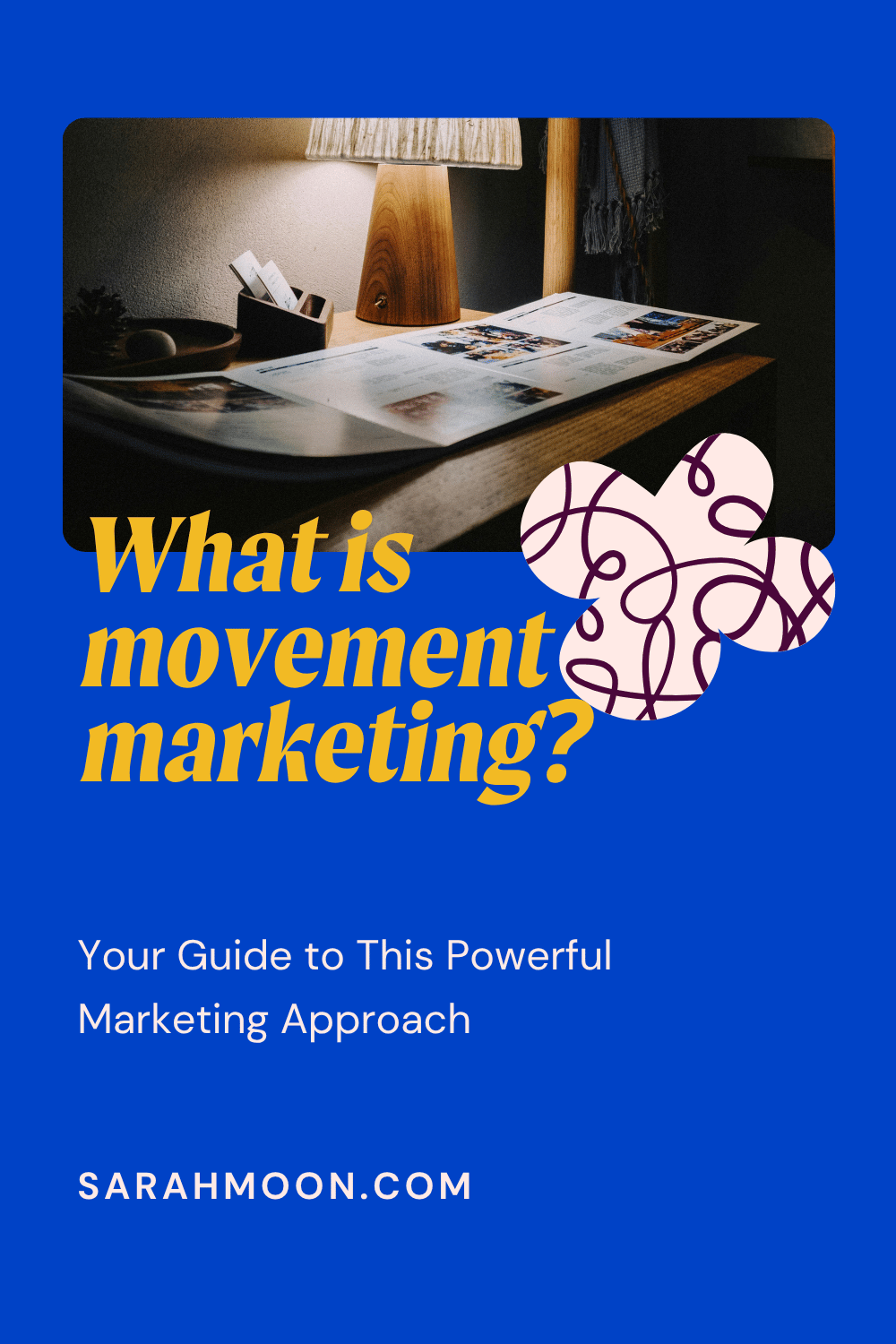What is Movement Marketing?
Five principles behind the Movement Marketing strategy.
Do you ever feel like the marketing advice you find online just doesn't feel right?
So many of our clients struggle with the advice they've been given by colleagues and experts around marketing—well-intended as it often is.
Maybe it's misaligned with your brand voice or leaving you feeling uninspired. As a result, you're just not taking action because that action feels... not great.
Whether we're a purpose-driven brand offering products, a service-based business aiming for big impact, or a mission-focused organization creating social and cultural change—we all need and want to create a financially sustainable model.
However, common marketing advice is so laser-focused on sales that our traditional marketing methods cause us to lose sight of our larger goals. This gap between our larger goals and what we're being sold daily is where the idea of Movement Marketing really galvanizes our clients searching for more from their marketing.
Movement Marketing is a marketing approach that centers on ideas that benefit a collective. It asks marketers to stop focusing on their service or product and instead center on a cultural or social shift or a widely-recognized problem.
I realize that's a lot to untangle, so let's break it down some more with one of my favorite well-known examples: Warby Parker, the online glasses store.
Glasses aren't the most glamorous topic, but they're something many of us (me included) find to be a frequent annoyance. Their origin story consists of this key concept:
"Every idea starts with a problem. Ours was simple: Glasses are too expensive."
The metaphorical dragon they're trying to slay is expensive glasses, price-controlled by the Luxottica glasses cartel.
That dragon is another critical element of Movement Marketing: We must unite around a common enemy.
Warby Parker's "Why"
How many people can identify with the phenomenon of needing glasses and being unable to afford glasses? Unfortunately, it's a common problem, and Warby Parker has a solution. If this is your problem, it's an easy bridge to cross from "Yes, I am sick of inaccessible eyewear also" to "I believe in your message and have bought your product."
Their brand invites people to see the possibilities: What would it be like to be able to access stylish, affordable glasses?
What if we defeated the glasses cartel—together? For many people, it would be indeed a life changer.
When a product- or service-based businesses use Movement Marketing to its full potential, you also see others adopting the same approach. As a result, you've sparked a movement that you no longer truly own but are the standard-bearer or leader of this change.
Sure, they market their product, but if you dig into their messaging repeatedly, it's always about the need for affordable, accessible eyewear. This message is also the root of the company's one-for-one campaign (buy a pair, give a pair—like Tom's Shoes).
Movement Marketing is not the same as Cause Marketing, though the two share many similarities and have some crossover.
Now, as you can see from the one-for-one element of Warby Parker, Tom's Shoes, and others, it could be very easy to conflate Movement Marketing and Cause Marketing.
In fact, Rachel Rodgers (whose company, HelloSeven, often uses the framework of Movement Marketing in their messaging) recently mischaracterized Movement Marketing precisely this way when she wrote,
"And this doesn't need to be directly tied to your product or service. You could be a bookkeeper who supports animal rights. You could own a vinyl records store that supports Black Lives Matter.
Your movement doesn't necessarily need to be linked to a charitable cause, either — big ideas work too. For example, back in the day, Apple broke away from traditional technology marketing with the idea that tech can be fun and accessible."
What Rachel described in the first paragraph is actually Cause Marketing and absolutely not Movement Marketing. Cause Marketing can be very effective and the right approach for many businesses. But it's not the same thing at all, and yet this remains a common misconception.
Cause marketing promotes an issue or organization in tandem with traditional product or service-focused marketing. Many one-for-one programs fit in this mold, as do the charitable giving programs and social advocacy that are a wonderful part of many companies' culture.
However, this approach sometimes slides into what we call "Cause-Washing," a common marketing technique to deflect problems via Cause Marketing.
(One of my favorite examples is Windex's new bottles, which they proudly claim to be "recovered ocean plastic" but are really plastics from plastics banks. The practice itself is great but doesn't negate that their parent company largely contributes to the ocean plastics crisis.)
On the other hand, Movement Marketing requires full alignment, which I’ll dig into in a moment.
Movement Marketing requires pushing big ideas and demanding a cultural or social shift (aka your movement).
You cannot have Movement Marketing without big ideas. Full stop. End of sentence. Again, without that, it's Cause Marketing. Change can only start with big ideas about what's possible—remember, movement marketing demands change and inspires others to join your movement.
Let's step away from the easy examples of product-based Movement Marketing and consider how service providers can leverage this approach.
At SM&Co, we often work with solo and small law practices. What differentiates our clients from the law firms other marketing agencies work with is that our clients are trying to change a small part of their industry or communities.
For example, one of our consulting clients is a family law firm. They deeply believe that the mediation model they practice not only positively impacts their client families during their most difficult times but that by helping create harmonious family transitions, they have a big impact on the larger communities those families live in.
This model is a big idea—and it's not the typical litigious model people expect from divorce lawyers. Ultimately, they're hoping to spark a movement and inspire others to adopt this model as well, turning their small company's ripple into a wave of change in their industry.
Movement Marketing aligns your big idea (your movement) internally and externally, top-to-bottom.
The brilliant product marketing agency Strawberry Frog originated the term Movement Marketing many years ago. They are exceedingly clear that their work around Movement Marketing is both an external (your customers) and internal (your people) process. Our team talks about this through the lens of what we've termed "Aligned Authority™."
This combination of external and internal perspectives is another point where companies and organizations falter with their Movement Marketing efforts. I saw this repeatedly when I led nonprofit and public sector marketing departments.
Movement Marketing exposes organizational misalignment, often in unexpected ways, by expected sources (Allyson Felix's exposure of Nike's treatment of female athletes is a classic case of this).
For example, suppose your organization campaigns for improved labor practices to truly leverage the power of Movement Marketing. In that case, you will need to prove to your potential supporters that you walk the walk and infuse the principles you're advocating for into your own organization's labor practices.
Think of your internal Movement Marketing as leading by example, starting with the executive team. (Yes, even if you're an executive team of one.) Without this alignment, your Movement Marketing efforts will fail.
Movement Marketing is often deeply misunderstood, but its beauty and power are in its dynamism.
Unlike most marketing philosophies, which often focus on product and consistent repetition of product benefits, Movement Marketing inherently evolves side by side with your movement.
Why does all this matter? Movement Marketing matters because if you want to build a business or organization that creates a lasting impact, this is the best marketing approach to do just that.
Yes, it’s hard. Yes, you must dive deeply to be successful with this method. Yes, you will polarize your audience. (Are any of those negatives? I don’t think so.)
But aligning your authority in this way will reward your expertise and passion many times over.
Movement Marketing sounds pretty great, right? We think so too.
7 Key Takeaways About Movement Marketing
Movement Marketing is a marketing approach that centers on ideas that benefit a collective. It asks marketers to stop focusing on their service or product and instead center on a cultural or social shift or a widely-recognized problem.
Movement Marketing demands we unite around a common enemy. Warby Parker is a famous example of taking on the industry of high-priced eyeglasses.
Movement Marketing is not the same as Cause Marketing, though the two share some similarities.
Movement Marketing requires pushing big ideas and demanding a cultural or social shift, also known as your movement.
Movement Marketing must include an internal adoption of leading by example, starting with the executive team.
Movement Marketing is often deeply misunderstood, but its beauty and power are in its dynamism. It's sustainable because you can adjust and adapt as support for your movement grows.
Effective Movement Marketing inspires others to join you and turns your company's ripple into a wave of change in your industry.







Sarah Moon Consulting has a brand new look! Take a look behind the scenes of my rebrand and borrow some lessons from my own branding journey.